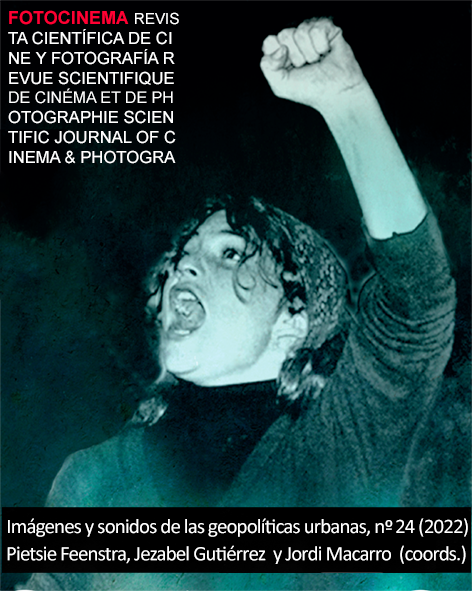An attentive gaze. The work with the image from an approach to the artwork of Chantal Akerman as performativity
DOI:
https://doi.org/10.24310/Fotocinema.2022.vi24.13773Keywords:
Chantal Akerman, Performativity, Image, Artistic ResearchAbstract
The work proposes to investigate everyday life to generate forms based on the image as a performative device. In this way, the text is articulated from the concept of image performativity from the creative process of Chantal Akerman, to recover the image-forming power and the importance it acquires in our lives, in the face of a reality anesthetized by the repetition of the pictures. Thus, the work is intended to answer these images from performativity to open possible imaginaries. For this, the text is organized according to an approximation to the work of the filmmaker Chantal Akerman. Working with the image through the autobiographical, everyday life and memory, experimenting with the elements offered by the artistic medium to create new relationships, annotations for an artistic investigation from performativity as an emergency.
Downloads
Metrics
Publication Facts
Reviewer profiles N/A
Author statements
Indexed in
-
—
- Academic society
- N/A
- Publisher
- Universidad de Málaga
References
Akerman, C. (2020). Una familia en Bruselas. Madrid: Editorial Tránsito.
Aznar, Y. (2015). Prácticas artísticas contemporáneas. Madrid: Editorial Centro de Estudios Ramón Aceres, S.A.
Bachelar, G. (1978). El agua y los sueños. Ensayo sobre la imaginación de la materia. México: Fondo de cultura económica.
Bergstrom, J. (1997), La femme a la caméra: intrevista di Jane Bergstrom a Babette Mangolte". En Il Cinema di Chantal Akerman, Adriano Apra y Bruno Di Marino (eds.). Roma: Editorial Dino Audino.
Berger, J. (2015). Para entender la fotografía. Barcelona: Editorial Gustavo Gili, S. A.
Berger, J. (2016). Modos de ver. Barcelona: Editorial Gustavo Gili, S. A.
Borgdorff, H. (2005) El debate sobre la investigación en las artes. Amsterdam School of the Arts: Paises Bajos. https://es.scribd.com/document/279835961/BORGDORFF-El-Debate-Sobre-La-Investigacion-en-Las-Artes
Cuevas, E. (2010). La casa abierta. El cine doméstico y sus reciclajes contemporáneos. Madrid: Ocho y medio.
De Sousa, B. (2010). Descolonizar el saber, reinventar el poder. Uruguay: Trilce.
Deleuze, G. (1987). ¿Qué es el acto de creación? Conferencia dada por Gilles Deleuze en la cátedra de los martes de la fundación FEMIS. https://www.youtube.com/watch?v=dXOzcexu7Ks
Fischer-Lichte, E. (2011). La estética de lo performativo. Madrid: Abada Editorial.
Garcés, M. (2013) Un mundo común. Barcelona: Bellaterra
Giorgio A. (2001) Notas sobre el gesto. En Medios sin fin. Notas sobre la política, Pre-textos. Valencia: Trafic
González, L.; Raich, Ll. (2020). Sobre la imagen poética. Correspondencia. Cantabria: Muga.
Kuhn, A. (1991). Cine de mujeres. Feminismo y cine. Madrid: Ediciones Cátedra, S. A.
Maillard, C. (2021) La razón estética. Barcelona: Galaxia Gutenberg
Margulies, I. (1996). Nothing Happens. Durham. Carolina: Editorial Universidad Duke.
Mekas, J. (2013) En el camino, de cuando en cuando, vislumbré breves momentos de belleza. Comparative Cinema, 2013, Num. 3, https://raco.cat/index.php/Comparativecinema/article/view/271786 [View: 31-08-2021].
Moran, J. (2002) There´s No Place Like Home Video. Mineapolis: Editorial Universidad de Minnesota.
Odin, R. (2010). El cine doméstico en la institución familiar. En E. Cuevas Álvarez, La casa abierta. El cine doméstico y sus reciclajes contemporáneos (p. 39-60). Madrid: Ocho y Medio.
Rancière, J. (2011). El destino de las imágenes. Argentina: Prometeo Libros.
Sánchez, S., Fernández, A. A. (2016). La intimidad como acto político. Sobre Grey Gardens y el cine autobiográfico de Chantal Akerman. L'Atalante. Revista de estudios cinematográficos, 22, (77-86).
Sontag, S. (2010). Ante el dolor de los demás. Barcelona: Penguin Random House, Grupo Editorial, S.A.U.
Sontag, S. (2011). Sobre la fotografía. Barcelona: Penguin Random House. Grupo Editorial, S.A.U.
Soto, A. (2020) La performatividad de las imágenes. Madrid: Ediciones Metales Pesados.
Toucedo, D. (2020). Solo nos queda el cuerpo. En Akerman, C. (Ed.) Una familia en Bruselas. (pp.74-81) Madrid: Editorial Tránsito.
Downloads
Published
How to Cite
Issue
Section
License
All contents published in Fotocinema Revista científica de cine y fotografía are protected under the Creative Commons Attribution-NonCommercial-ShareAlike 4.0 International (CC BY-NC-SA 4.0) license. All about this license is available in the following link: <http://creativecommons.org/licenses/by-nc-sa/4.0>
Users can copy, use, redistribute, share and exhibit publicly as long as:
- The original source and authorship of the material are cited (Journal, Publisher and URL of the work).
- It is not used for comercial purposes.
- The existence of the license and its especifications are mentioned.
There are two sets of authors’ rights: moral and property rights. Moral rights are perpetual prerogatives, unrenounceable, not-transferable, unalienable, imprescriptible and inembargable. According to authors’ rights legislation, Fotocinema. Revista científica de cine y fotografía recognizes and respects authors moral rights, as well as the ownership of property rights, which will be transferred to University of Malaga in open access. The property rights are referred to the benefits that are gained by the use or the dissemination of works. Fotocinema. Revista científica de cine y fotografía is published in an open access form and it is exclusively licenced by any means for doing or authorising distribution, dissemination, reproduction, , adaptation, translation or arrangement of works.
Authors are responsable for obtaining the necessary permission to use copyrighted images.














13.png)



